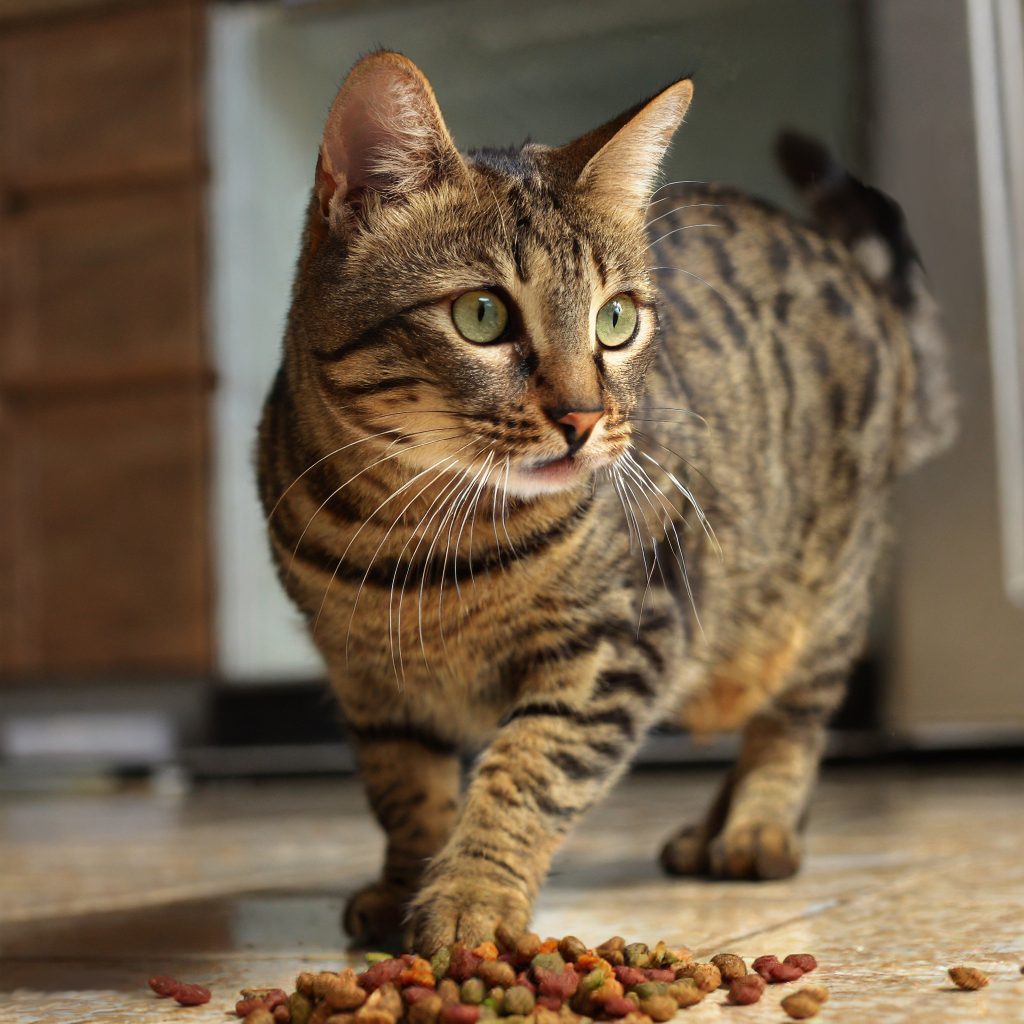Cats are at the same time wonderful companions and really weird roommates. Their peculiar eating habits alone can leave you scratching your head, so read on for some insight into why our feline friends do the things they do when it’s chow time, along with tips for appropriately handling these quirky cat mannerisms.
Pouncing and Playing: The Predatory Nature of Cats and Food
Cats are natural-born hunters, as you’ve probably seen firsthand when they zoom around batting and pouncing on toys. This instinct extends to food, where your whiskered warrior might tap, swat, or even “attack” their meal. Cats essentially see their food as prey, even if it’s not alive. Watching kibble scatter across the kitchen floor can be annoying, but keep in mind this behavior aligns with your cat’s primal instincts.
Kittens in particular are prone to playing with their food as they hone their hunting skills. Allow some supervised play, but restrict meals to set feeding times in designated areas to establish good habits. Offering puzzle feeders or toys that dispense food can also satisfy your cat’s urge to “hunt” for their grub. Just be patient and let them embrace their inner big-catness during chow time!

Green Grazing: Why Cats Snack on Houseplants
Does your cat circle, scratch, or “bury” their food dish before eating? Or do they vocally complain until you shake up or stir their food for them? These funny behaviors link back to cats’ ancestral habits. Circling and pawing at food resembles how wild felines would bury surplus prey to save for later. Meowing for their food to be freshened also mimics wild cats demanding parents regurgitate food for them.
For domestic kitties, food-focused behaviors like scratching and meowing are likely more habit than necessity. But indulge them occasionally if it comforts your cat. Gently shaking or stirring food to refresh it satisfies the urge to have “fresher” meals. And providing frequent, smaller meals rather than large bowls can minimize circling and covering behaviors.
H2O Huh? Your Cat’s Wild Water Habits
Cats can be pretty persnickety about their water sources. Yours may insist on drinking from a running faucet or freshly filled water bowl. Cats also tend to take longer, more frequent sips rather than lapping up large gulps like dogs do. This behavior comes from their wild origins, where running streams provided the freshest, safest water sources. Stagnant water risked carrying bacteria, parasites, or contaminants.
To satisfy your cat’s taste for flowing water, consider a circulating water fountain made for pets. The moving stream will entice them to drink more often. Wash bowls and refresh water frequently to provide the cleanest drinking experience. And even with a quality water source in your home, your cat may opt for the occasional faucet slurp — just go with the flow! It satisfies their instinct for pure, fresh water.
Midnight Nosh: Why Cats Wake You Up for Late-Night Meals
It’s definitely frustrating. Your cat wakes you up by meowing, pawing, or even nibbling you for a wee-hours snack. Blame their ancestral habits and physiology. In the wild, cats are most active at dawn and dusk when prey is abundant. So they’ve evolved to alternating cycles of eating and resting throughout the night accordingly.
Domestic cats retain these ingrained rhythms, expecting food when their energy rises at night. Wet food often intensifies midnight snacking since its aroma and appearance mimic freshly caught prey. Feeding your cat a meal before bedtime could satisfy those nighttime cravings. Playtime before bed also helps them expend pent-up energy so they’re less likely to rouse you for snacks. It takes some extra attention, but you can temper those pesky midnight munchies over time.
Litter Box Buffet: Gross but Typical Cat Behavior
Last and certainly least appetizing: some cats are drawn to snack on their own feces or litter. Nope, it’s not just a dog thing. And yup, it’s as gross as it sounds. But this revolting tendency has reasonable roots. In the wild, felines avoid fouling areas near their den and food sources to avoid contamination. Consuming feces was an evolutionary adaptation to keep dens tidy.
For pet cats, litter box snacking is simply instinctual habit, not nutritional need. Monitor the habit closely, as it can signal underlying medical issues requiring treatment. Discourage the behavior by keeping litter boxes super clean, using finer-grained litters, and placing boxes far from food and water. Talk to your vet too, as they can recommend supplements or medications if litter snacking becomes excessive. With patience and care, you can curb this cringey cat conduct.
Embracing Your Cat’s Mealtime Quirks
Your cat’s odd food fixations simply trace back to their ancestors and natural instincts. While confusing at times, such kitty quirkiness and mealtime mischief shouldn’t be a serious concern. With some guidance, cats can adapt their behaviors to a domestic setting peacefully. As any cat lover knows, we delight in them even when — or especially when — they’re being uniquely cats. So embrace your curious cat and the joy they bring, and above all, provide them the care, love, and acceptance their wonderful weirdness deserves!
